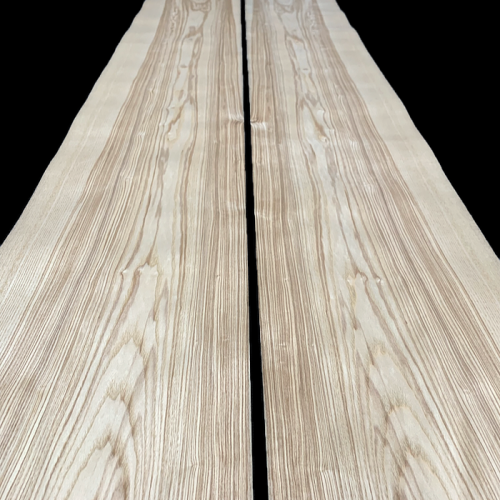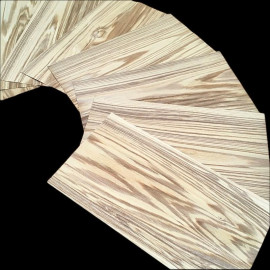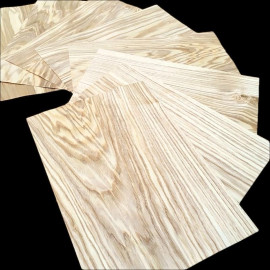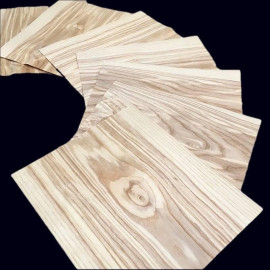
Olive Ash 0.3 mm Veneers 280 x 36 cm
Olive Ash 0.3 mm Veneers 280 x 36 cm
Genuine wood sliced-veneer sheets, in sequence.
Length: 280 cm.
Width: 36 cm.
Thickness: 0.3 mm.
Sold by the sheet.
These photos are taken from the veneer sheets you will receive.
Warning: Carefully read the full description of these veneers.
Olive Ash 0.3 mm Veneers 280 x 36 cm
Genuine wood sliced-veneer sheets, in sequence.
Warning:
0.3mm is twice thinner than the standard 0.6 mm thickness.
This thickness is ideal for making complex wrapping or using its translucency in lampshade craft.
Dimensions:
Length: 280 cm.
Width: 36 cm.
Thickness: 0.3 mm.
Measurement scaling:
The width is rounded to the covered centimeter. For example, 15.8 cm is given 15 cm.
The length is rounded to 5 centimeters. For example, 257 cm is given 255 cm.
Pictures:
Pictures herewith are actual photos of the product you will receive.
What is Olive Ash?
Olive Ash is named for its distinctive, irregular brown grain pattern that resembles the grain of olive wood.
It belongs to the same species as white ash. This characteristic grain pattern typically develops with the tree's age, progressing from the heartwood to the sapwood.
The edges of Olive Ash veneers often retain their youthful, light color.
Common Names
Ash, white ash, Olive Ash, and European white ash.
Botanical Name
Fraxinus excelsior.
Origin
It is generally native to northern Europe, extending from the tip of Brittany to the Ural Mountains.
How to Recognize Olive Ash wood?
Olive Ash is a hard texture yet lightweight wood with a light white to yellow hue. Its appearance is remarkably uniform, except for the Olive Ash Burl, which showcases contrasting brown grains.
The grain pattern of Ash is usually regular, except for burls.
Ash possesses an open-pored structure that is desirable for achieving an accent finish.
Mechanical Properties
Weight: 680 kg/m³, average at 10-12% moisture content.
Janka hardness: 6580 Newton; for comparison, oak is 4980 N, and poplar is 1650 N.
Elasticity: 12.31 Gigapascals; for comparison, American maple is 12.62 GPa, and poplar is 9.75 GPa.
Tensile strength: 51 Megapascals, for comparison, US maple is 109 MPa and oak is 47.3 MPa.
Uses
Olive Ash's remarkable flexibility makes it suitable for a wide range of applications, including tool handles, alpine and Nordic skis, skateboards, surfboards, bows, and other sports equipment, as well as in the construction, automotive, and naval industries.
Aesthetically, Olive Ash is ideal for accent finishes, where its open-pored grain creates striking contrasts. Additionally, it is traditionally used in components subject to friction, like drawer slides, as its self-lubricating properties reduce wear.
Product Description:
Genuine wood-sliced veneer sheets.
These veneers are raw without a finish or any fleece back.
The veneer surface is similar to plane wood. However, it will be preferable to forecast a light sanding after gluing.
The veneers are offered here as wood-sliced sheets of one and unique thickness.
Both faces of these veneers are the same, without fleece back, without glue.
Even if the veneer's sides had been cut relatively straight, it isn't a precise parallel clipping; some veneers may have kept the decreasing shape of the tree, wider at the bottom end and narrower at the top end.
Very occasionally, some veneers' sides have traces of unclipped wane, but our veneers are measured at the narrowest, as explained in the paragraph "sizes."
As genuine natural wood, all finishing products are acceptable as long as they are meant for wood use.
The choice of the finished product must be consistent with the final usage realization.
Use of the veneers:
Cutting:
Veneers can be easily cut with a utility knife.
For straight cuts, the best results are obtained with a veneer saw.
Use a fretsaw, scalpel, or veneer knife for curved cuts.
Always allow for a slightly larger veneer sheet than your intended surface. This will allow you to adjust the size after gluing for a clean finish.
A flush trimmer can also be used to trim the veneer after gluing.
When cutting with a utility knife or veneer knife, it is best to cut with the grain of the wood. To check this, run your finger along the edge of the sheet. The direction that feels smoothest is the ideal direction for cutting.
Gluing:
Several types of gluing are possible.
- With vinylic glue, the veneer is pressed over its entire surface.
- With neoprene glue to all surfaces, especially non-porous surfaces, by applying two coats of glue and marouflage.
With animal glue such as hide, sinew, or bone glue.
With vinyl glue and an iron, apply two thin coats of glue to each piece. This technique should only be used if other gluing techniques are not possible.
Sanding:
Veneers and all our products are genuine wood and can be sanded according to thickness.
Please do not use a belt sander, regardless of the thickness of the veneer, as this could pierce it.
With a 0.6 mm veneer, lightly sand with 120 grit and then finish with 180 or 240 grit. With an orbital sander, 180 grit is already sufficient for most applications.
Finishing:
All finishing products generally used for wood are suitable for finishing our products. For example, you can use a varnish, wax, paint, or oil.
However, ensure that the product you want to use is compatible with the final use of your creation.
More information:
Please look at our TUTORIALS; you might find some valuable tips.
Please get in touch with us by email or phone for any additional information.
Data sheet
- Species
- Ash
- Thickness group
- Thin thickness
- Grade
- Crown-cut
You might also like
 English
English








